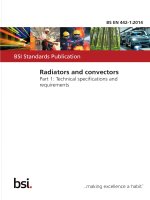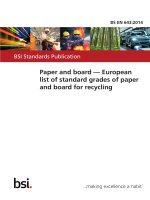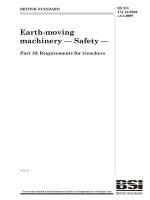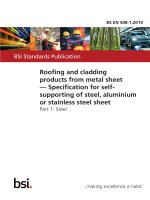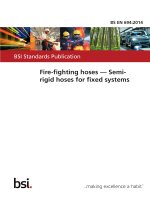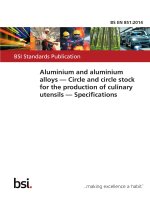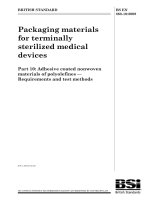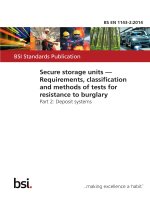Bsi bs en 16603 32 10 2014
Bạn đang xem bản rút gọn của tài liệu. Xem và tải ngay bản đầy đủ của tài liệu tại đây (1.09 MB, 28 trang )
BS EN 16603-32-10:2014
BSI Standards Publication
Space engineering — Structural
factors of safety for spaceflight
hardware
BS EN 16603-32-10:2014
BRITISH STANDARD
National foreword
This British Standard is the UK implementation of EN
16603-32-10:2014.
The UK participation in its preparation was entrusted to Technical
Committee ACE/68, Space systems and operations.
A list of organizations represented on this committee can be
obtained on request to its secretary.
This publication does not purport to include all the necessary
provisions of a contract. Users are responsible for its correct
application.
© The British Standards Institution 2014. Published by BSI Standards
Limited 2014
ISBN 978 0 580 83982 5
ICS 49.140
Compliance with a British Standard cannot confer immunity from
legal obligations.
This British Standard was published under the authority of the
Standards Policy and Strategy Committee on 31 August 2014.
Amendments issued since publication
Date
Text affected
BS EN 16603-32-10:2014
EN 16603-32-10
EUROPEAN STANDARD
NORME EUROPÉENNE
EUROPÄISCHE NORM
August 2014
ICS 49.140
English version
Space engineering - Structural factors of safety for spaceflight
hardware
Ingénierie spatiale - Facteurs de sécurité pour les structure
spatiales
Raumfahrttechnik - Strukturelle Sicherheitsfaktoren für
Raumflughardware
This European Standard was approved by CEN on 10 February 2014.
CEN and CENELEC members are bound to comply with the CEN/CENELEC Internal Regulations which stipulate the conditions for giving
this European Standard the status of a national standard without any alteration. Up-to-date lists and bibliographical references concerning
such national standards may be obtained on application to the CEN-CENELEC Management Centre or to any CEN and CENELEC
member.
This European Standard exists in three official versions (English, French, German). A version in any other language made by translation
under the responsibility of a CEN and CENELEC member into its own language and notified to the CEN-CENELEC Management Centre
has the same status as the official versions.
CEN and CENELEC members are the national standards bodies and national electrotechnical committees of Austria, Belgium, Bulgaria,
Croatia, Cyprus, Czech Republic, Denmark, Estonia, Finland, Former Yugoslav Republic of Macedonia, France, Germany, Greece,
Hungary, Iceland, Ireland, Italy, Latvia, Lithuania, Luxembourg, Malta, Netherlands, Norway, Poland, Portugal, Romania, Slovakia,
Slovenia, Spain, Sweden, Switzerland, Turkey and United Kingdom.
CEN-CENELEC Management Centre:
Avenue Marnix 17, B-1000 Brussels
© 2014 CEN/CENELEC All rights of exploitation in any form and by any means reserved
worldwide for CEN national Members and for CENELEC
Members.
Ref. No. EN 16603-32-10:2014 E
BS EN 16603-32-10:2014
EN 16603-32-10:2014 (E)
Table of contents
Foreword .................................................................................................................... 4
1 Scope ....................................................................................................................... 5
2 Normative references ............................................................................................. 7
3 Terms, definitions and abbreviated terms............................................................ 8
3.1
Terms and definitions ...............................................................................................8
3.2
Terms specific to the present standard .....................................................................8
3.3
Abbreviated terms.....................................................................................................9
4 Requirements........................................................................................................ 10
4.1
4.2
4.3
Applicability of structural factors of safety ............................................................... 10
4.1.1
Overview ...................................................................................................10
4.1.2
Applicability ...............................................................................................10
4.1.3
General .....................................................................................................10
4.1.4
Design factor for loads .............................................................................. 10
4.1.5
Additional factors for design ...................................................................... 12
Loads and factors relationship ................................................................................13
4.2.1
General .....................................................................................................13
4.2.2
Specific requirements for launch vehicles ................................................. 15
Factors values ........................................................................................................16
4.3.1
Test factors ...............................................................................................16
4.3.2
Factors of safety .......................................................................................17
Annex A (informative) Qualification test factor for launch vehicles ..................... 21
Bibliography............................................................................................................. 23
Figures
Figure 4-1: Logic for Factors of Safety application ................................................................ 14
Figure 4-2: Analysis tree.......................................................................................................15
2
BS EN 16603-32-10:2014
EN 16603-32-10:2014 (E)
Tables
Table 4-1: Relationship among (structural) factors of safety, design factors and
additional factors ................................................................................................14
Table 4-2: Test factor values ................................................................................................16
Table 4-3: Factors of safety for metallic, FRP, sandwich, glass and ceramic structural
parts ...................................................................................................................18
Table 4-4: Factors of safety for joints, inserts and connections............................................. 19
Table 4-5: Factors of safety for buckling ...............................................................................20
Table 4-6: Factors of safety for pressurized hardware .......................................................... 20
3
BS EN 16603-32-10:2014
EN 16603-32-10:2014 (E)
Foreword
This document (EN 16603-32-10:2014) has been prepared by Technical
Committee CEN/CLC/TC 5 “Space”, the secretariat of which is held by DIN.
This standard (EN 16603-32-10:2014) originates from ECSS-E-ST-32-10C Rev.1.
This European Standard shall be given the status of a national standard, either
by publication of an identical text or by endorsement, at the latest by February
2015, and conflicting national standards shall be withdrawn at the latest by
February 2015.
Attention is drawn to the possibility that some of the elements of this document
may be the subject of patent rights. CEN [and/or CENELEC] shall not be held
responsible for identifying any or all such patent rights.
This document has been developed to cover specifically space systems and has
therefore precedence over any EN covering the same scope but with a wider
domain of applicability (e.g. : aerospace).
According to the CEN-CENELEC Internal Regulations, the national standards
organizations of the following countries are bound to implement this European
Standard: Austria, Belgium, Bulgaria, Croatia, Cyprus, Czech Republic,
Denmark, Estonia, Finland, Former Yugoslav Republic of Macedonia, France,
Germany, Greece, Hungary, Iceland, Ireland, Italy, Latvia, Lithuania,
Luxembourg, Malta, Netherlands, Norway, Poland, Portugal, Romania,
Slovakia, Slovenia, Spain, Sweden, Switzerland, Turkey and the United
Kingdom.
4
BS EN 16603-32-10:2014
EN 16603-32-10:2014 (E)
1
Scope
The purpose of this Standard is to define the Factors Of Safety (FOS), Design
Factor and additional factors to be used for the dimensioning and design
verification of spaceflight hardware including qualification and acceptance
tests.
This standard is not self standing and is used in conjunction with the ECSS-EST-32, ECSS-E-ST-32-02 and ECSS-E-ST-33-01 documents.
Following assumptions are made in the document:
•
that recognized methodologies are used for the determination of the limit
loads, including their scatter, that are applied to the hardware and for the
stress analyses;
•
that the structural and mechanical system design is amenable to
engineering analyses by current state-of-the-art methods and is
conforming to standard aerospace industry practices.
Factors of safety are defined to cover chosen load level probability, assumed
uncertainty in mechanical properties and manufacturing but not a lack of
engineering effort.
The choice of a factor of safety for a program is directly linked to the rationale
retained for designing, dimensioning and testing within the program.
Therefore, as the development logic and the associated reliability objectives are
different for:
•
unmanned scientific or commercial satellite,
•
expendable launch vehicles,
•
man-rated spacecraft, and
•
any other unmanned space vehicle (e.g. transfer vehicle, planetary probe)
specific values are presented for each of them.
Factors of safety for re-usable launch vehicles and man-rated commercial
spacecraft are not addressed in this document.
For all of these space products, factors of safety are defined hereafter in the
document whatever the adopted qualification logic: proto-flight or prototype
model.
For pressurized hardware, factors of safety for all loads except internal pressure
loads are defined in this standard. Concerning the internal pressure, the factors
5
BS EN 16603-32-10:2014
EN 16603-32-10:2014 (E)
of safety for pressurised hardware can be found in ECSS-E-ST-32-02. For loads
combination refer to ECSS-E-ST-32-02.
For mechanisms, specific factors of safety associated with yield and ultimate of
metallic materials, cable rupture factors of safety, stops/shaft shoulders/recess
yield factors of safety and limits for peak Hertzian contact stress are specified in
ECSS-E-ST-33-01.
Alternate approach
The factors of safety specified hereafter are applied using a deterministic
approach i.e. as generally applied in the Space Industry to achieve the
structures standard reliability objectives. Structural safety based on a
probabilistic analysis could be an alternate approach but it has to be
demonstrated this process achieves the reliability objective specified to the
structure. The procedure is approved by the customer.
This standard may be tailored for the specific characteristics and constraints of a
space project in conformance with ECSS-S-ST-00.
6
BS EN 16603-32-10:2014
EN 16603-32-10:2014 (E)
2
Normative references
The following normative documents contain provisions which, through
reference in this text, constitute provisions of this ECSS Standard. For dated
references, subsequent amendments to, or revision of any of these publications,
do not apply. However, parties to agreements based on this ECSS Standard are
encouraged to investigate the possibility of applying the more recent editions of
the normative documents indicated below. For undated references, the latest
edition of the publication referred to applies.
EN reference
Reference in text
Title
EN 16601-00-01
ECSS-S-ST-00-01
ECSS system – Glossary of terms
EN 16603-10-02
ECSS-E-ST-10-02
Space engineering – Verification
EN 16603-10-03
ECSS-E-ST-10-03
Space engineering – Testing
EN 16603-32
ECSS-E-ST-32
Space engineering – Structural general requirements
EN 16603-32-02
ECSS-E-ST-32-02
Space engineering – Structural design and
verification of pressurized hardware
7
BS EN 16603-32-10:2014
EN 16603-32-10:2014 (E)
3
Terms, definitions and abbreviated terms
3.1
Terms and definitions
For the purpose of this Standard, the terms and definitions from ECSS-S-ST-00-01,
ECSS-E-ST-10-02, ECSS-ST-E-10-03, and ECSS-E-ST-32 apply.
3.2
Terms specific to the present standard
3.2.1
local design factor (KLD)
factor used to take into account local discontinuities and applied in series with
FOSU or FOSY
3.2.2
margin policy factor (KMP)
factor, specific to launch vehicles, which includes the margin policy defined by
the project
3.2.3
model factor (KM)
factor which takes into account the representativity of mathematical models
3.2.4
project factor (KP)
factor which takes into account at the beginning of the project the maturity of
the design and its possible evolution and programmatic margins which cover
project uncertainties or some growth potential when required
3.2.5
prototype test
test performed on a separate flight-like structural test article
3.2.6
protoflight test
test performed on a flight hardware
3.2.7
test factors (KA and KQ)
factors used to define respectively the acceptance and the qualification test
loads
3.2.8
ultimate design factor of safety (FOSU)
multiplying factor applied to the design limit load in order to calculate the
design ultimate load
8
BS EN 16603-32-10:2014
EN 16603-32-10:2014 (E)
3.2.9
yield design factor of safety (FOSY)
multiplying factor applied to the design limit load in order to calculate the
design yield load
3.3
Abbreviated terms
For the purpose of this standard, the abbreviated terms from ECSS-S-ST-00-01
and the following apply.
Abbreviation
Meaning
AL
acceptance test load
DLL
design limit load
DUL
design ultimate load
DYL
design yield load
FOS
factor of safety
FOSU
ultimate design factor of safety
FOSY
yield design factor of safety
FRP
fibre reinforced plastics
GSE
ground support equipment
KA
acceptance test factor
KQ
qualification test factor
LCDA
launch vehicle coupled dynamic analysis
LL
limit load
N/A
not applicable
QL
qualification test load
S/C
spacecraft
9
BS EN 16603-32-10:2014
EN 16603-32-10:2014 (E)
4
Requirements
4.1
Applicability of structural factors of safety
4.1.1
Overview
The purpose of the factors of safety defined in this Standard is to guarantee an
adequate level of mechanical reliability for spaceflight hardware.
4.1.2
a.
Applicability
The factors specified in clauses 4.1.4, 4.1.5 and 4.3 shall be applied for:
1.
Structural elements of satellites including payloads, equipment
and experiments.
NOTE
b.
2.
The expendable launch vehicles structural elements.
3.
Man-rated spacecraft structures including payloads, equipments
and experiments.
The factors in clauses 4.1.4, 4.1.5 and 4.3 shall be applied for both the
design and test phases as defined in Figure 4-1.
4.1.3
a.
General
Design factor and additional factors values shall be agreed with the
customer.
4.1.4
Design factor for loads
4.1.4.1
General
a.
For determination of the Design Limit Load (DLL) the Design Factor shall
be used, this is defined as the product of the factors defined hereafter.
NOTE
10
These factors are not applied for the GSE sizing
and qualification.
Robustness of the sizing process is considered
through the Design Limit Loads (DLL).
BS EN 16603-32-10:2014
EN 16603-32-10:2014 (E)
4.1.4.2
a.
b.
Model factor
A “model Factor" KM shall be applied to account for uncertainties in
mathematical models when predicting dynamic response, loads and
evaluating load paths.
NOTE 1
The model factor is applied at every level of the
analysis tree system (Figure 4-2) where predictive
models are used. It encompasses the lack of
confidence in the information provided by the
model, e.g. hyperstaticity (uncertainty in the load
path because of non accuracy of the mathematical
model), junction stiffness uncertainty, noncorrelated dynamic behaviour.
NOTE 2
While going through the design refinement loops,
KM can be progressively reduced to 1,0 after
demonstration of satisfactory correlation between
mathematical models and test measurements.
NOTE 3
For launch vehicles, at system level, KM is also
called “system margin”.
KM value shall be justified.
NOTE
4.1.4.3
a.
Project factor
A specific “project factor” KP shall be applied to account for the maturity
of the program (e.g. stability of the mass budget, well identified design)
and the confidence in the specification given to the project (this factor
integrates a programmatic margin e.g. for growth potential for further
developments).
NOTE
b.
The value of this factor is generally defined at
system level and can be reduced during the
development.
KP value shall be justified.
NOTE
4.1.4.4
a.
Justification can be performed based on
relevant historical practice (e.g. typical values
of 1,2 are used for satellites at the beginning of
new development and 1,0 for internal pressure
loads for pressurized hardware), analytical or
experimental means.
Justification can be performed based on
relevant historical practice or on foreseen
evolutions.
Qualification test factor
The qualification factor KQ shall be applied for satellites.
NOTE
For satellites, the qualification loads are part of
the specified loads and are accounted for in the
dimensioning process. This is different for
11
BS EN 16603-32-10:2014
EN 16603-32-10:2014 (E)
launch vehicles for which QL are consequences
of the dimensioning process.
4.1.5
Additional factors for design
4.1.5.1
Overview
All the analysis complexity or inaccuracies and uncertainties not mentioned in
clause 4.1.4 are taken into account with the following additional factors.
4.1.5.2
a.
Local design factor
A “local design factor”, KLD shall be applied when the sizing approach or
the local modelling are complex.
NOTE
b.
This factor accounts for specific uncertainties
linked to the analysis difficulties or to the lack
of reliable dimensioning methodology or
criteria where significant stress gradients occur
(e.g. geometric singularities, fitting, welding,
riveting, bonding, holes, inserts and, for
composite, lay-up drop out, sandwich core
thickness change, variation of ply consolidation
as a result of drape over corners).
KLD values shall be justified.
NOTE 1
Justification can be performed based on relevant
historical practice, analytical or experimental
means.
NOTE 2
For satellites, a typical value of 1,2 is used in the
following cases:
• Composite structures discontinuities;
• Sandwich structures discontinuities (face
wrinkling, intracell buckling, honeycomb s
hear);
• Joints and inserts.
NOTE 3
4.1.5.3
a.
The use of a local design factor does not preclude
appropriate engineering analysis (e.g. KLD does not
cover the stress concentration factors) and
assessment of all uncertainties.
Margin policy factor
A “margin policy” factor KMP shall be applied for launch vehicles.
NOTE
This factor, used to give confidence to the
design, covers (not exhaustive list):
• the lack of knowledge on the failure modes
and associated criteria.
• the lack of knowledge on the effect of
interaction of loadings.
12
BS EN 16603-32-10:2014
EN 16603-32-10:2014 (E)
• the non-tested zones.
b.
4.2
KMP values shall be justified.
NOTE 1
Justification can be performed based on relevant
historical practice, analytical or experimental
means.
NOTE 2
KMP can have different values according to the
structural area they are dedicated to.
Loads and factors relationship
4.2.1
a.
General
QL, AL, DLL, DYL, and DUL, for the test and the design of satellite,
expendable launch vehicles, pressurized hardware and man-rated system
shall be calculated from the LL as specified in Figure 4-1 and Table 4-1.
NOTE 1
As a result of the launch vehicle-satellite coupled
dynamic load analysis (LCDA) performed during
the project design and verification phases, the
knowledge of the LL can be modified during the
course of the project, leading to a final estimation
of the loads LLfinal. Then for final verification, it is
used as a minimum:
QL = KQ × LLfinal
for qualification, and
AL = KA × LLfinal
for acceptance
NOTE 2
The yield design factor of safety (FOSY) ensures a
low probability of yielding during loading at DLL
level.
NOTE 3
The ultimate design factor of safety (FOSU)
ensures a low probability of failure during loading
at DLL level.
b.
The application logic for factors of safety as given in Figure 4-1 shall be
applied in a “recursive” manner from system level to subsystem level or
lower levels of assembly.
c.
DLL computed at each level shall be used as LL for analysis at their own
level to compute the DLL for the next lower levels of assembly.
NOTE
d.
This is graphically shown in Figure 4-2.
For satellite, KQ shall be used only at system level in order to avoid
repetitive application of qualification margins.
13
BS EN 16603-32-10:2014
EN 16603-32-10:2014 (E)
Satellites
Test Logic
Common Design Logic
Expendable launch vehicles,
pressurized hardware and
manned system Test Logic
Limit Loads - LL
Increasing Load Level
x KQ
QL
x KA
x Coef. A
AL
Design Limit Loads
DLL
x Coef. B
x Coef. C
x KQ
x KA
AL
DYL
DUL
QL
Figure 4-1: Logic for Factors of Safety application
Table 4-1: Relationship among (structural) factors of safety, design factors and
additional factors
14
Coefficient
Satellite
Launch vehicles and
pressurised hardware
Man-rated systems
Coef A
or
Design factor
KQ x KP x KM
KP x KM
KP x KM
Coef B
FOSY x KLD
FOSY x KMP x KLD
FOSY x KLD
Coef C
FOSU x KLD
FOSU x KMP x KLD
FOSU x KLD
BS EN 16603-32-10:2014
EN 16603-32-10:2014 (E)
Limit Loads
at system level
System
(KQ(1)),
KM ,
KP,
Design Limit Loads
=
Limit Loads
for subsystem
or component
Subsystem or
component
KP, KM,
Design Limit Loads
KLD , FOS
(KMP(2))
DYL, DUL
KQ(1): for satellite
KMP(2): for launch vehicles
Figure 4-2: Analysis tree
4.2.2
a.
Specific requirements for launch vehicles
The QL shall be defined with a corrected KQ.
NOTE 1
The correction takes into account manufacturing
variability and difficulties of having test conditions
fully representative of flight conditions.
NOTE 2
The commonly used method for defining the
corrected KQ is presented in Annex A for
information.
15
BS EN 16603-32-10:2014
EN 16603-32-10:2014 (E)
4.3
Factors values
4.3.1
a.
Test factors
The test factors KQ and KA shall be selected from Table 4-2.
Table 4-2: Test factor values
Requirements
Load type
Comments
Vehicle
KQ
KA
Satellite
1,25 a
1
Launch vehicle
1,25corrected b
1 or Jp c
Global flight loads
Manrated
S/C
Internal pressure
Launch loads
1,4
On orbit
loads
1,5
1,2
in conformance with ECSS–E-ST-32-02 i
Satellite
1,25 a, e
1
Launch vehicle
1,25 e
N/A
f
Satellite
2
N/A
Hoisting loads g
(fail safe)
Satellite
1
N/A
Dynamic local loads d
Hoisting loads
Typical value to be
considered for
dimensioning are
Jp=1,05 to 1,1
Applicable for satellite
and launch vehicles
Satellite
Storage and
transportation loads
Thermal loads h
-local transportation
and storage loads
2
-other transportation
loads
1,4
Satellite
1
1
Launch vehicle
1
1
N/A
a
A higher value can be specified by the Launch vehicle Authority or the customer.
b
See clause 4.2.2.
c
Jp is the proof factor for pressurized structure.
d
Local loads are system level loads computed e.g. on units, appendages, equipments, fixtures during dynamic analyses.
e
The value applies for qualification tests under local load conditions. A higher value can be specified for specific purposes.
f
National laws can specify higher values.
g
Fail safe means in case of loss of one of the hoisting slings. In this case, the limit load (LL) is determined by using peak
dynamic load due to the failure of the hoisting sling.
h
Thermal loads (i.e. mechanical load of thermo elastic origin) are taken with a qualification/acceptance factor equal to 1 by
using temperature and gradients levels at qualification/acceptance levels where the qualification/acceptance level
temperature includes thermal prediction uncertainty plus a qualification/acceptance temperature margin.
i
KQ is defined as "Burst Factor" and KA is defined as "Proof Factor" in ECSS-E-ST-32-02.
16
BS EN 16603-32-10:2014
EN 16603-32-10:2014 (E)
4.3.2
Factors of safety
4.3.2.1
Metallic, FRP, sandwich, glass and ceramic
structural parts
a.
The factor of safety for metallic, FRP, sandwich, glass and ceramic
structural parts shall be selected from Table 4-3.
b.
For satellites and man-rated spacecraft, the factors provided in Table 4-3
shall apply for all additive loads including thermal induced loads.
c.
For satellites and man rated spacecraft, when loads including thermal
induced loads are relieving, both FOSU and FOSY shall be 1,0 or less.
NOTE
d.
See ECSS-E-ST-32.
For expendable launch vehicles, FOSU and FOSY associated with thermal
induced loads shall be 1,0.
17
BS EN 16603-32-10:2014
EN 16603-32-10:2014 (E)
Table 4-3: Factors of safety for metallic, FRP, sandwich, glass and ceramic
structural parts
Requirements
Structure type
Metallic parts
FRP parts
(away from
discontinuities)
FRP parts
(discontinuities) a
Sandwich parts:
- face wrinkling
- intracell
buckling
- honeycomb shear
Glass and ceramic
structural parts
FOSY
FOSU
FOSY
verification by
analysis only
Satellite
1,1
1,25
1,25
2,0
Launch vehicle
1,1
1,25
See Note c
2,0
Man-rated S/C
Launch
On Orbit
1,25
1,1
1,4
1,5
See Note c
See Note c
Satellite
N/A
1,25
N/A
2,0
Launch vehicle
N/A
1,25
N/A
2,0
Man-rated S/C
Launch
On Orbit
N/A
N/A
1,5
2,0
N/A
N/A
See Note c
Satellite
N/A
1,25
N/A
2,0
Launch vehicle
N/A
1,25
N/A
2,0
Man-rated S/C
N/A
2,0 b
N/A
See Note c
Satellite
N/A
1,25
N/A
2,0
Launch vehicle
N/A
1,25
N/A
2,0
Man-rated S/C
N/A
1,4
N/A
See Note c
Satellite
N/A
2,5
N/A
5,0
Launch vehicle
N/A
See Note c
N/A
See Note c
Man-rated S/C
N/A
3,0
N/A
See Note c
Vehicle
a
e.g.: holes, frames, reinforcements, steep change of thickness.
b
This value is for consistency with NASA-STD-5001 and already include a KLD factor.
c
No commonly agreed value within the space community can be provided.
18
FOSU
verification by
analysis only
BS EN 16603-32-10:2014
EN 16603-32-10:2014 (E)
4.3.2.2
a.
Joints, inserts and connections
The factor of safety for joints, inserts and connections shall be selected
from Table 4-4.
Table 4-4: Factors of safety for joints, inserts and connections
Requirements
Structure type
FOSY
FOSU
FOSY
verification
by analysis
only
Satellite
N/A
N/A
N/A
1,25
N/A
N/A
N/A
1,25
1,25
2,0
N/A
N/A
Launch vehicle
N/A
1,1
1,1
1,25
N/A
N/A
N/A
N/A
Man-rated S/C
See Note c
1,4
1,4
1,4
See Note c
See Note c
Satellite
See Note c
2,0
See Note c
See Note c
Launch vehicle
See Note c
2,0
See Note c
See Note c
Vehicle
Joints and inserts: a
- Failure
- Gapping
- Sliding
Elastomer system
and elastomer to
structure connectionb
FOSU
verification
by analysis
only
a
These factors are not applied on the bolts preload – see threaded fasteners guidelines handbook (ECSS-EHB-32-23).
b
Analysis and test are performed to show that the possible non linear dynamic behaviour of the elastomer
does not jeopardize the satellite strength and alignment.
c
No commonly agreed value within the space community can be provided.
4.3.2.3
a.
Buckling
The factor of safety for global and local buckling shall be selected from
Table 4-5.
NOTE
The factor of safety does not cover the knock
down factors commonly used in buckling
analyses - see Buckling handbook (ECSS-E-HB32-24).
19
BS EN 16603-32-10:2014
EN 16603-32-10:2014 (E)
Table 4-5: Factors of safety for buckling
Requirements
FOSY
FOSU
FOSY
verification
by analysis
only
See Note a
1,25
See Note a
2,0
- Global
N/A
1,25
See Note a
2,0
- Local
1,1
1,25
See Note a
1,4
Vehicle
Satellite
FOSU verification
by analysis only
Launch vehicle
Man-rated S/C
a
2,0
See Note a
N/A
No commonly agreed value within the space community can be provided.
4.3.2.4
a.
Pressurized hardware
The factor of safety for pressurized hardware, engine feeding lines, and
tank pressurisation lines shall be selected from Table 4-6 for the
mechanical loads except the internal pressure.
NOTE 1
For internal pressure loadings
combination, see ECSS-E-ST-32-02.
and
NOTE 2
Pressurized hardware is defined in ECSS-E-ST-32-02.
Table 4-6: Factors of safety for pressurized hardware
Requirements
FOSY
FOSU
FOSY
verification by
analysis only
Satellite
1,1
1,25
See Note a
See Note a
Launch vehicle
1,1
1,25
See Note a
See Note a
Man-rated S/C
1,25
1,4
See Note a
See Note a
Vehicle
a
20
FOSU
verification by
analysis only
No commonly agreed value within the space community can be provided.
loads
BS EN 16603-32-10:2014
EN 16603-32-10:2014 (E)
Annex A (informative)
Qualification test factor for launch vehicles
In European launch vehicle programs, the QL to be implemented during the
test is defined with a corrected KQ factor, derived by location and failure mode.
•
KQ is modified by correcting factors such as:
KQ = (FOSY × K min × K adj + K T )×
KQ = (FOSU × K min × K adj + K T ) ×
•
1
for loading at yield load
Kθ × Kσ
1
for loading at ultimate load
Kθ × Kσ
Taking into account the following points:
The actual thickness of qualification model versus thickness used
for sizing. This is done through the use of the correcting factor Kmin
which accounts for the effect of the thickness on the structure
strength. It corresponds to the ratio of the thickness measured on
the test specimen to the dimensioning thickness.
Kmin is only applicable to metal structures, for other structures,
Kmin=1.0 is used.
The adjacent structure's influence on the stress field between flight
and test conditions. This is done through the use of the correcting
factor Kadj which accounts for the influence of adjacent structures
not present during static tests.
o
If the adjacent flight structures are simulated during static
tests, Kadj=1,0 is used.
o
Else wise, Kadj is deduced as the ratio of the stress state
(σflight) computed in flight configuration to the stress state
computed in test configuration (σtest) increased by the
overflux factor used for the design.
K adj = max(1,0 ,
σ flight
× k overflux )
σ test
Effect of thermal gradient stress. This is done through the use of
the correcting factor KT which is defined as the ratio of the increase
in the stress due to the local thermal gradient to the stress
corresponding to no local thermal gradient.
21
BS EN 16603-32-10:2014
EN 16603-32-10:2014 (E)
The effect of temperature on mechanical characteristics (Young’s
modulus, strength…). This is done through the use of the
correcting factor Kθ which is the ratio of the mechanical
characteristics considered at flight operating temperature Cθ flight to
the ones at test temperature Cθ test.
Kθ =
Cθ
flight
Cθ
test
The influence of A-values for sizing and more probable values for
the material constitutive of the qualification model. This is done
through the use of the correcting factor Kσ. If f(Ci) is the function
translating the effect of characteristic Ci on the failure mode, the
correcting factor Kσ is defined as the ratio of f(Ci) for the
characteristic value used for design to f(Ci) for the characteristic
value of the tested specimen.
Kσ =
f (C i
f (C i
design
test
)
)
If several characteristics C1, C2,… are affecting the considered
failure mode, Kσ is defined as:
Kσ =
f (C1
f (C1
) × f (C
) f (C
design
test
) × ..... × f (C
)
f (C
2 design
2
test
n
design
n
test
)
)
The correcting factors are defined and agreed with the customer.
22
BS EN 16603-32-10:2014
EN 16603-32-10:2014 (E)
Bibliography
EN reference
Reference in text
Title
EN 16601-00
ECSS-S-ST-00
ECSS system – Description, implementation and
general requirements
ECSS-E-HB-32-23
Space engineering – Threaded fasteners handbook
ECSS-E-HB-32-24
Space engineering – Buckling handbook.
NASA-STD-5001
Structural design and test factors of safety for
spaceflight hardware (June 21, 1996)
A5-SG-1-X-10-ASAI
(issue 5.12, April the
8th; 2003)
Structure design, dimensioning and test specifications
23


